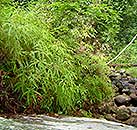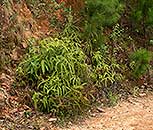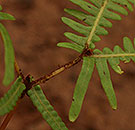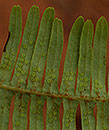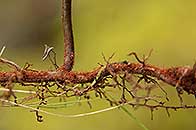Dicranopteris linearis (Burm. f.) Underw.
Synonyms |
Polypodium lineare Burm.f. |
|---|---|
Common name |
|
Description |
Rhizome widely creeping, brown, 1-5 mm in diameter, glabrous at maturity. Fronds spaced apart, bifurcate to reniform-lunate in outline. Stipe up to 1 m long, golden brown, glabrous. Lamina 2-3 times dichotomously divided with a pair of reduced pinnae present at each fork of the divisions; pinnae narrowly lanceolate, deeply pinnatifid, up to 12 x 4 cm. Pinnule lobes 15-30 (-50) × 5 mm, linear-oblong, glabrous on both surfaces, borne only on the ultimate branches, the other axes naked. Sori subcircular, c. 1 mm in diameter, arranged in two rows along the midrib of the pinnule lobes; exindusiate. |
Notes | Differs from Sticherus umbraculiferus by having pinnules only on the distal lamina axes; differs from Gleichenia polypodioides by having superficial sori that are not sunken into the lamina and pinnules that are linear. |
Derivation | linearis: linear, referring to the long pinnules. |
Habitat | Along moist streambanks, forest margins and roadsides, in light shade or exposed. |
Distribution worldwide | Widespread in tropical Africa, Madagascar, Comoro Isl., Seychelles, Mauritius, Réunion and Asia to Australasia and Polynesia. |
Distribution in Africa |
Angola, Benin, Burundi, Cameroon, Central African Republic, Congo, Dem. Republic of Congo, Equatorial Guinea (incl. Bioko), Ethiopia, Gabon, Ghana, Guinea, Ivory Coast, Kenya, Liberia, Malawi, Mozambique, Nigeria, Rwanda, Swaziland, Tanzania , Zambia, Zimbabwe. |
Growth form |
Lithophytic, terrestrial. |
Literature |
|

